The state of Colorado is one of the richest states when it comes to wildlife variety. In fact, according to the Colorado Bird Records Committee (CBRC) of Colorado Field Ornithologists, the state is home to about 511 bird species.
If you want to know more about the native birds in Colorado, this article has you covered. Today, we’ll provide you with a quick guide that walks you through some of the most impressive and interesting birds you’ll see while you’re in the Centennial State.
For your troubles, the list is also sorted according to the bird’s most characteristic colors. Here’s a brief overview of each one of them!
Red Birds in Colorado
House Finch

- Scientific Name: Haemorhous mexicanus
- Length: 4.9 to 6.1 in
- Weight: 0.6 to 0.9 oz
- Wingspan: 8.1 to 10.5 in
House Finches are widespread all over the United States and they’re easily identified by their unique colors. This familiar bird is known for the rosy red plumage that covers its face and breasts and varies according to the bird’s diet. However, these colors are only characteristic of male House Finches because females are usually a greyish or brown color.
Unlike many types of birds out there, you won’t have a hard time attracting these birds to your yard because they simply love bird feeders in the morning!
Northern Flicker

- Scientific Name: Colaptes auratus
- Length: 10.9 to 13.8 In
- Weight: 3.1 to 5.9 oz
- Wingspan: 17.8 to 21.2 In
These birds are also known as Common Flickers because they’re found across most regions of North America. They belong to the family of woodpeckers, however, they’re among the few that have distinctive colors.
Northern Flickers are identified by the red patch found on their neck, and black spots on their underparts, and they’re among the few woodpeckers that will land in your backyard.
This is because they mainly feed by sticking their thread-shaped tongues into ant colonies. But, they still might bang on wooden objects around your property to mark their territory.
Downy Woodpecker

- Scientific Name: Dryobates pubescens
- Length: 5.5 to 7.1 In
- Weight: 0.7 to 1.1 oz
- Wingspan: 9.8 to 12.2 In
The downy woodpecker is a mainly black-colored bird. But, like the Northern Flicker, one of the main identifying features of the bird is the characteristic red patch on its head. The other characteristic feature of downy woodpeckers, which are one of the most common birds in the state of Colorado, is their size.
These are not only the smallest species of woodpeckers in Colorado but also in the United States and Canada.
They have adapted very well to suburban life and will land in your yard in search of leftover food, such as donuts, as well as a range of fruits and seeds.
Summer Tanager
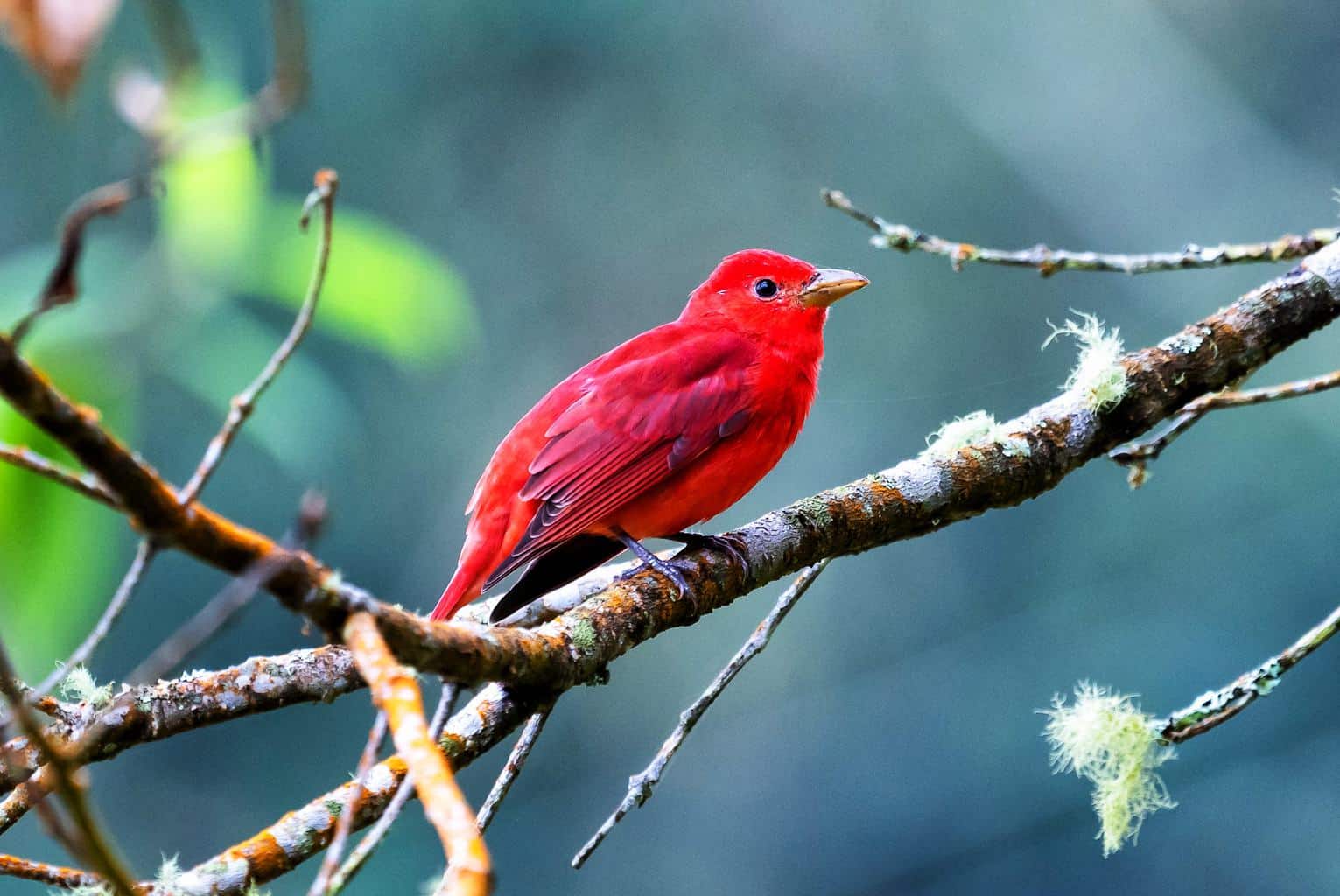
- Scientific Name: Piranga rubra
- Length: 6.1 to 6.9 in
- Weight: 0.8 to 1.1 oz
- Wingspan: 11.1 to 11.9 in
The Summer Tanagers are sparrow-sized songbirds that are known for their ruby red plumage all over the body while the head is slightly orange-red.
They have the same vocalization as other members of the Cardinal family. Moreover, they enjoy the same characteristics in terms of plumage patterns and feeding.
You can find them landing in your backyard if you have their favorite food, suet, in a bird feeder. And even if you don’t, they might come for food remains, such as fruit jams.
Hairy Woodpecker
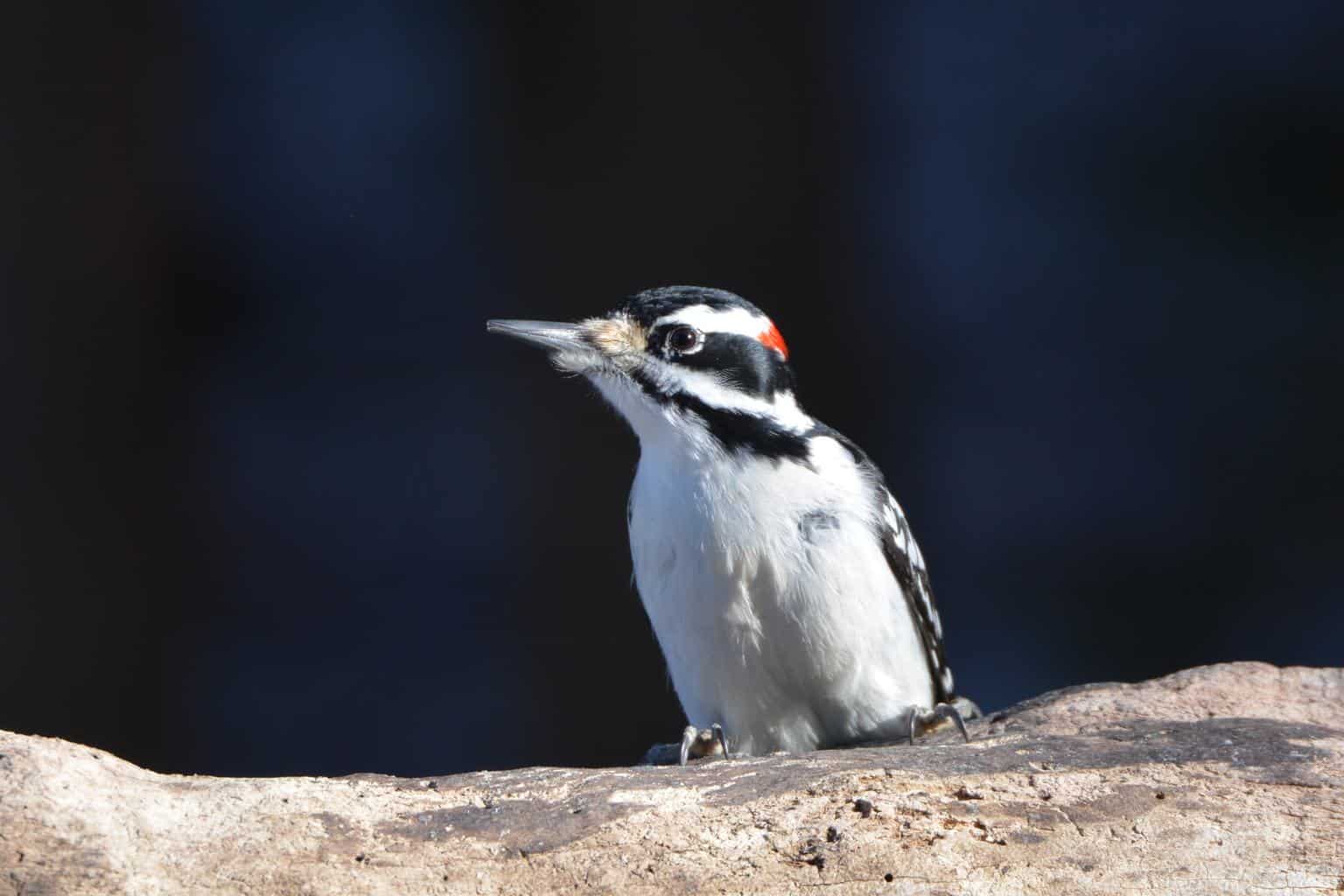
- Scientific Name: Dryobates villosus
- Length: 7.1 to 10.2 in
- Weight: 1.4 to 3.4 oz
- Wingspan: 13.0 to 17.0 in
The Hairy Woodpecker has a striking resemblance to the Downy Woodpecker. Both of them have the brilliant red patch on their head that makes them quite easy to spot, and the two of them are fairly common in Colorado.
However, the Hairy Woodpecker is somewhat bigger than the Downy Woodpecker and has a significantly larger bill compared to its body. Also, these birds have a stockier body than the Downys. Additionally, the Hairy Woodpecker’s outer tail feathers are white, while the Downy woodpeckers are spotted.
You can attract the Hairy Woodpecker using a similar kind of food that would appeal to Downy Woodpeckers. So, pay attention to the body size and the bill to tell them apart.
Red-Winged Blackbird

- Scientific name: Agelaius phoeniceus
- Length: 6.7 to 9.1 in
- Weight: 1.1 to 2.7 oz
- Wingspan: 12.2 to 15.8 in
Blackbirds are known for their entirely black-feathered bodies. However, what makes this unusual bird unique is that they have a noticeably bright red and yellow patch on their wings.
These birds are among the most common in Colorado and are easily spotted by entry-level bird watchers in the state. They’ve even spotted these birds in winter. You can spot Red-winged Blackbirds just about anywhere in Colorado where you find wetlands, streams, lakes, or marshes.
Blue Birds in Colorado
Belted Kingfisher

- Scientific name: Megaceryle alcyon
- Length: 11.0 to 13.8 In
- Weight: 4.9 to 6.0 oz
- Wingspan: 18.9 to 22.8 inch
The Belted Kingfisher is among the special birds of Colorado. They’re easily identifiable due to their special color patterns.
They have a long thin bill and a fuzzy crown on top of their heads. As for the colors, Kingfishers are mostly blue-gray on the head, back, and tail. The underparts are white on both adult males and females where the latter has a broad brown band that runs around their bellies like a belt, hence the name.
Mountain Bluebird
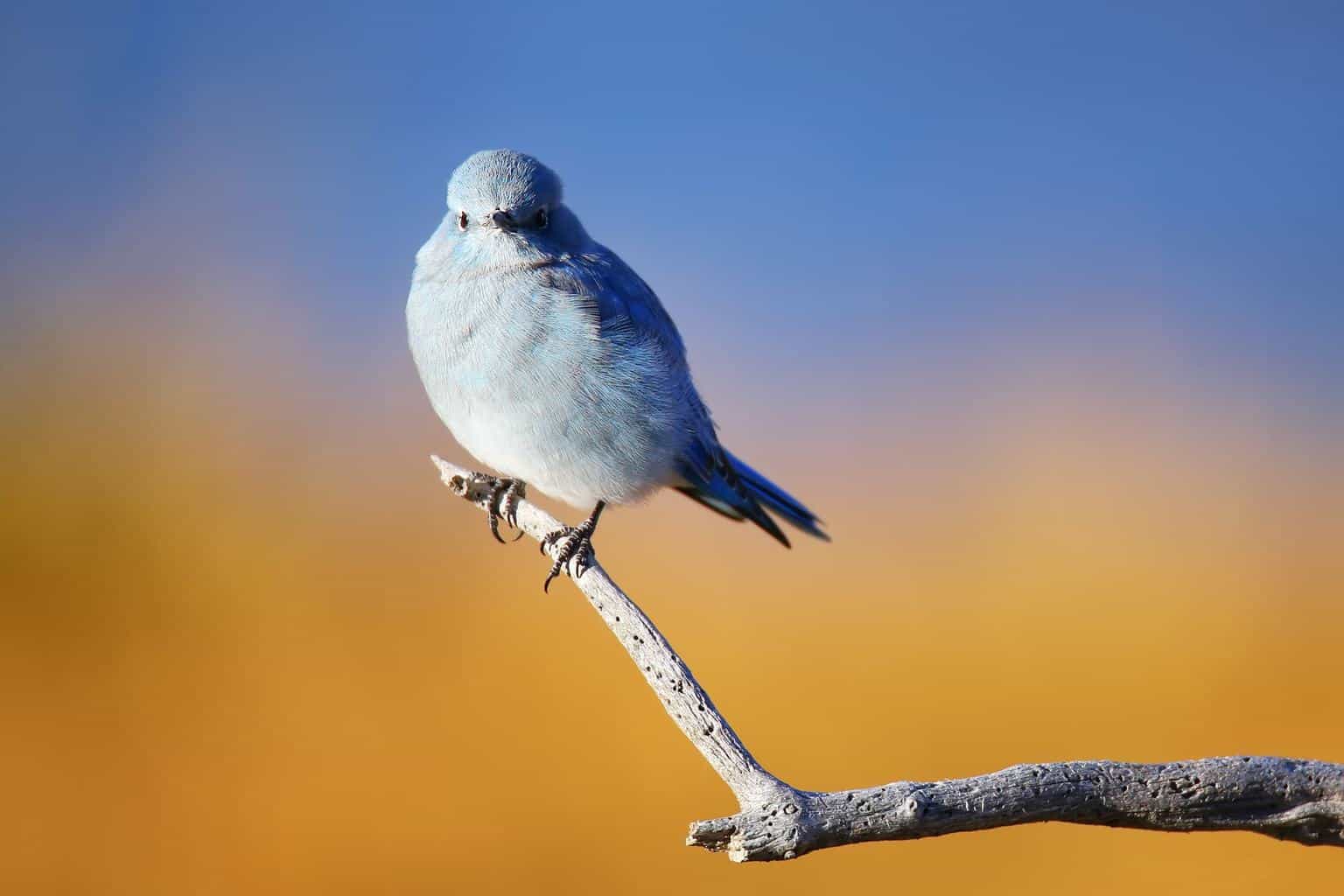
- Scientific name: Sialia currucoides
- Length: 6.3 to 7.9 in
- Weight: 1.0 to 1.2 oz
- Wingspan: 11.0 to 14.2 in
This alpine bird belongs to the thrush family and is a fairly common blue-colored bird in the state of Colorado as well as neighboring states.
They have black eyes and light underbellies but are mainly characterized by their turquoise blue plumage on the back and head that gets paler as you go towards the belly.
Mountain Bluebirds are relatively small and have a migration pattern that extends from Alaska south to Central America.
Common Grackle

- Scientific name: Quiscalus quiscula
- Length: 11.0 to 13.4 in
- Weight: 2.6 to 5.0 oz
- Wingspan: 14.2 to 18.1 in
The Common Grackle is a medium-large lanky bird that has a long tail as well as a long bill that curves downward gently, just like blackbirds.
These birds are fairly loud and will usually gather in large flocks. They live high up in trees around forests.
What characterizes these birds is their color pattern. The male usually has an iridescent blue head combined with a bronze body, with purplish feathers that shine from certain angles. Females have the same colors and plumage, except they’re a little less vibrant and glossy.
Western Scrub-Jay

- Scientific name: Aphelocoma californica
- Length: 11.0 to 11.8 in
- Weight: 2.5 to 3.5 oz
- Wingspan: 15.0 to 15.5 in
They’re also known as the “California Scrub-Jay”. These birds are identified by their small bills and long tails. The most eye-catching feature of this western bird, however, is the blue color on its wings, tail, and head.
Their backs are fairly brown but are overshadowed by the vibrant blue color, especially when they’re seen from a distance. The underside of the bird is slightly tan to off-white and they don’t have a crest.
Blue-Throated Mountain Gem
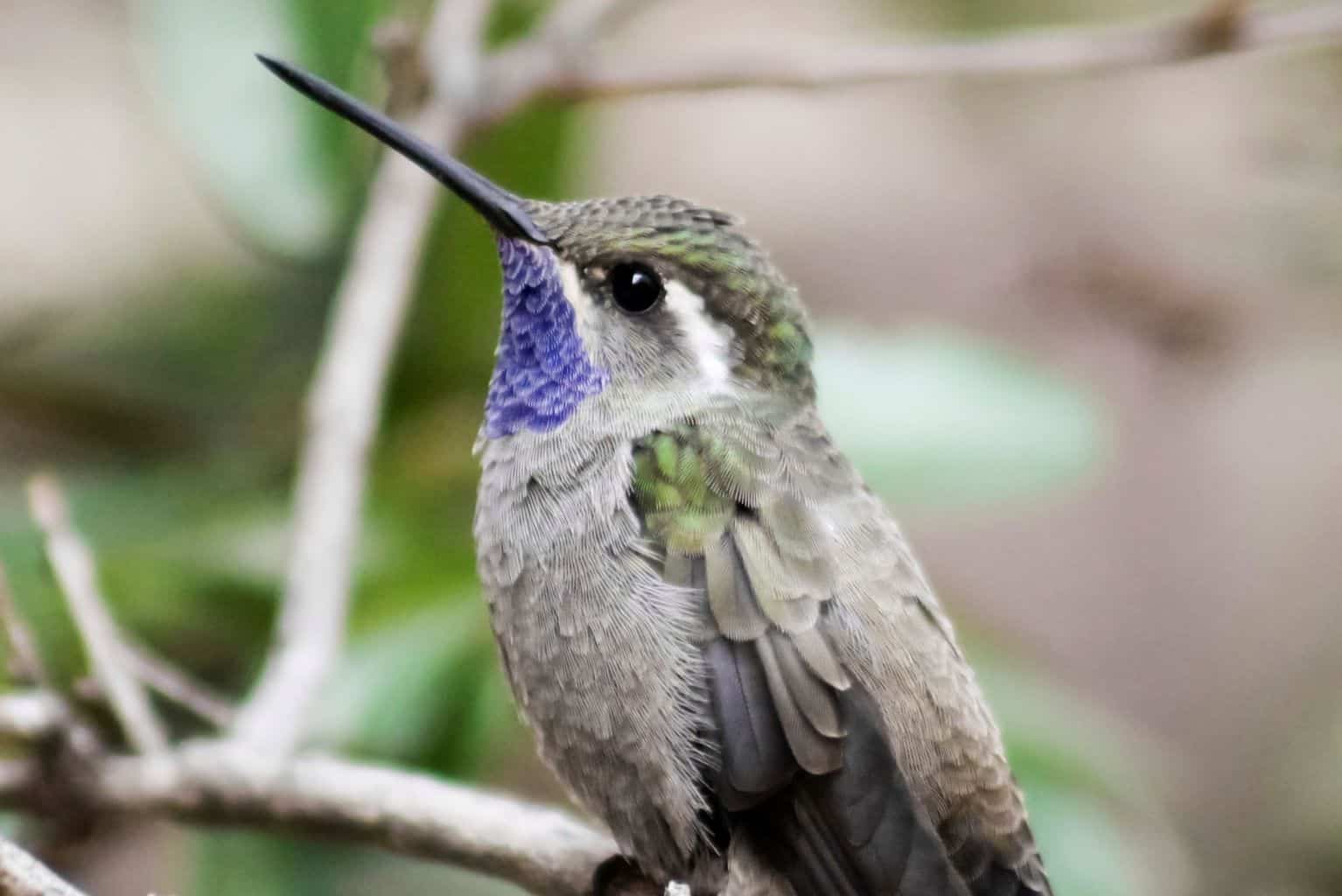
- Scientific Name: Lampornis clemenciae
- Length: 4.5 to 4.9 in
- Weight: 0.2 to 0.3 oz
- Wingspan: 2.7 to 3.1 in
They’re also known as the “Blue-throated Hummingbird” because they technically belong to the family of hummingbirds. However, these birds are slightly bigger and have extended wings as well as fuller tails.
They usually follow smaller hummingbirds to feed on nectars, too. However, when there isn’t enough nectar around, these birds will feed on small insects and spiders to stay full.
Male Blue-throated Mountain Gems have bright blue feathers with bronzy green hues and white lines just below their eyes.
Green Birds in Colorado
Broad-Billed Hummingbird

- Scientific Name: Cynanthus latirostris
- Length: 3.1 to 3.9 In
- Weight: 0.11 to 0.14 oz
- Wingspan: 5.1 to 5.6 In
The Broad-billed Hummingbird is another unique species of hummingbirds because they have green plumage that shines brightly if you look at it from the right angle.
They also have a tinge of blue feathers that gives off a greenish sheen which makes these hummingbirds stand out among others for being one of the prettiest to look at.
Put out your feeders during hummingbird season for a real visual treat.
Broad-Tailed Hummingbird
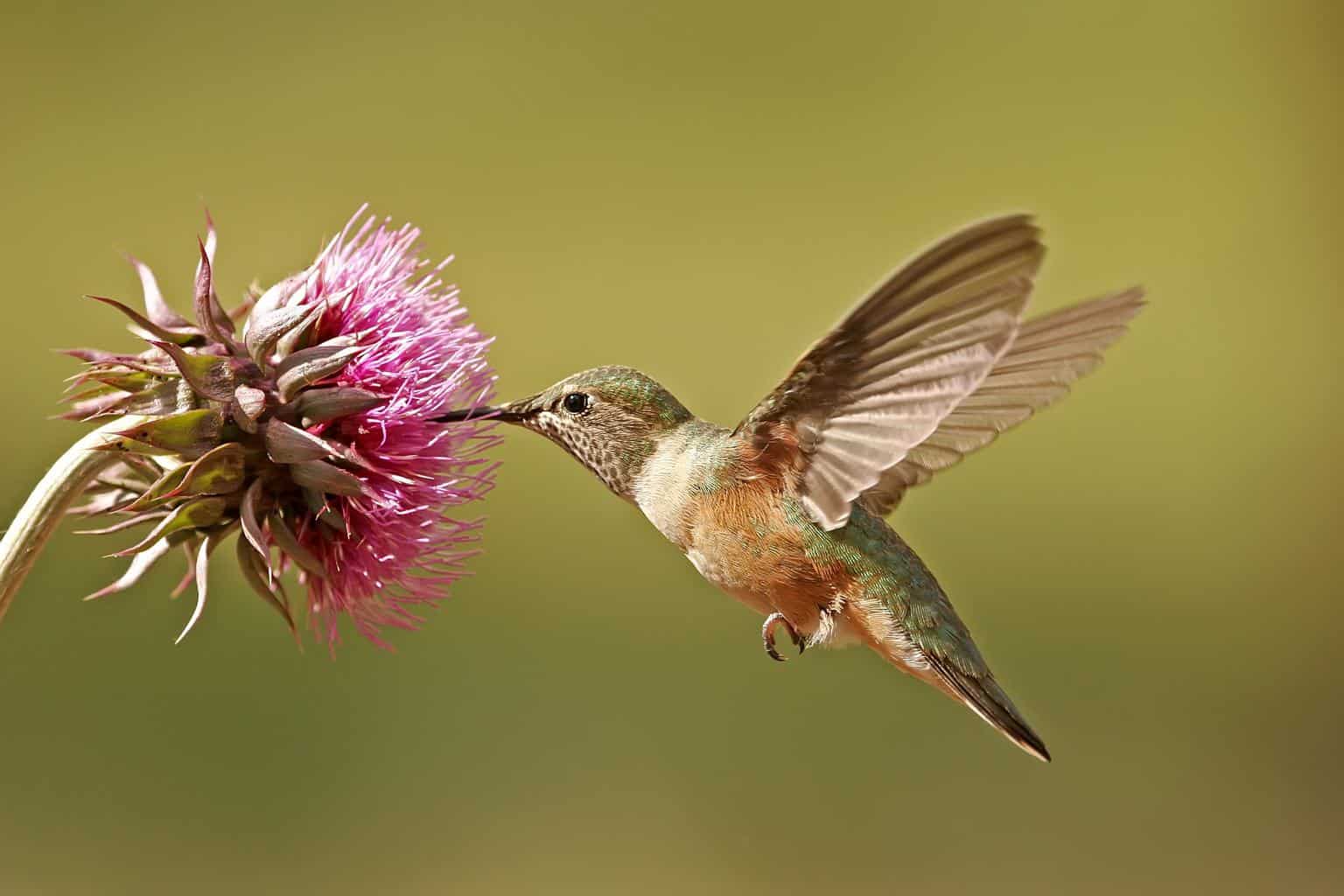
- Scientific name: Selasphorus platycercus
- Length: 3.1 to 3.5 in
- Weight: 0.1 to 0.2 oz
- Wingspan: 5.2 to 5.3 in
Despite having a somewhat similar name, this hummingbird is very different from the Broad-billed Hummingbird.
The Broad-tailed Hummingbird is mainly green in color, as they have green plumage on their head, back, wings, and tail. Their plumage is also fairly iridescent.
However, what stands out as a characteristic feature of these colorful birds is the pinkish red iridescent feathers on their throats. They behave like other birds and will be attracted to the nectar in flowers or hummingbird feeders.
Violet-Green Swallow
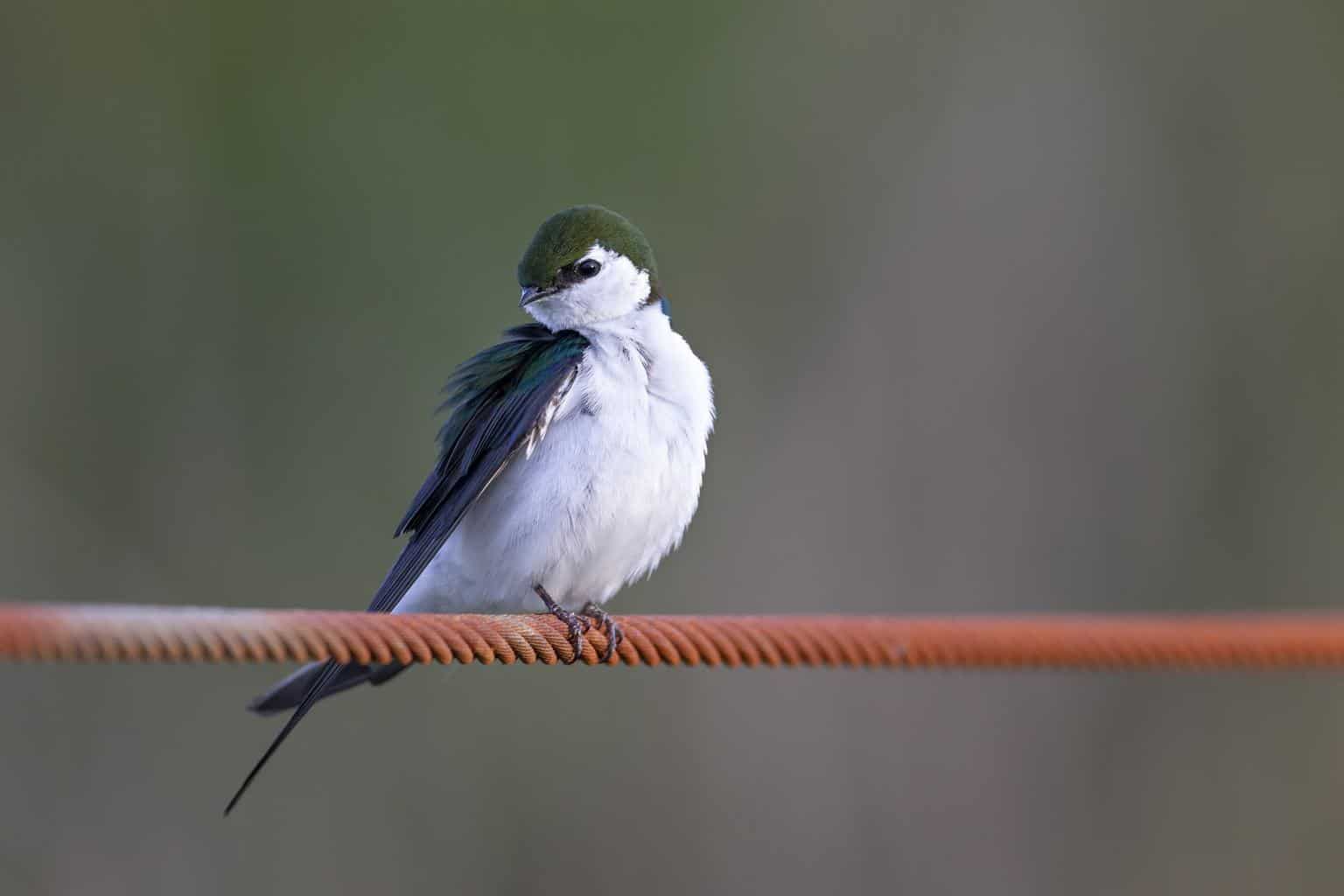
- Scientific name: Tachycineta thalassina
- Length: 4.5 to 5.0 in
- Weight: 0.4 to 0.6 oz
- Wingspan: 10.1 to 11.0 in
The Violet-green Swallow is one of the most common breeding swallows in the state. If you’re in the right place, it’s also one of the easiest green-color birds to spot because they live in groups. You have a very good chance to spot these birds in summer, as well.
They have dark green feathers on their back and the top of the head and are known for their acrobatic aerial style at various heights.
It’s easy to spot them flying over water bodies foraging for flying insects, their favorite meal. When they’re not searching for food, they perch on tree branches and telephone wires.
Orange Birds in Colorado
Varied Thrush
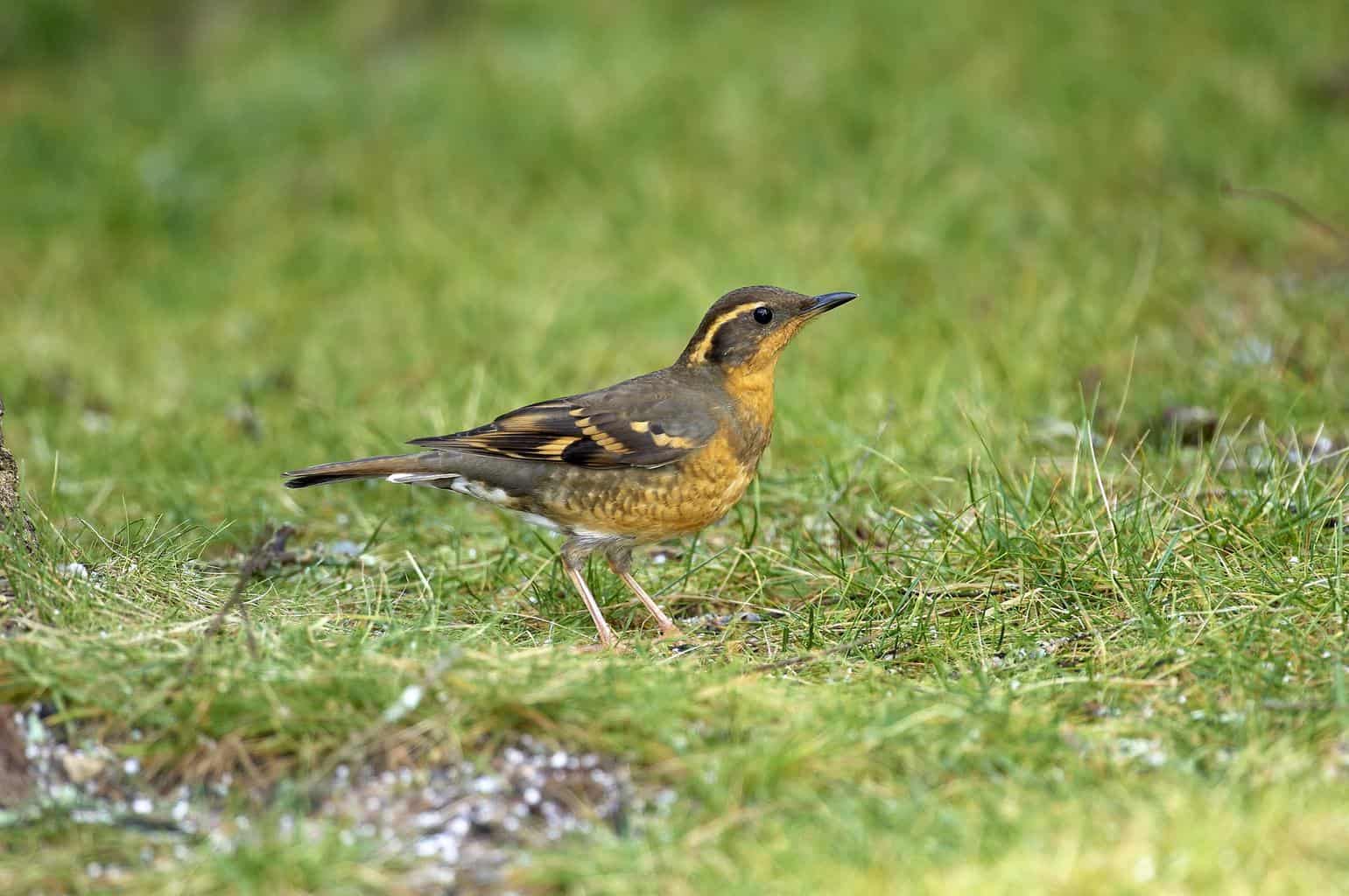
- Scientific Name: Ixoreus naevius
- Length: 7.5 to 0.2 In
- Weight: 2.3 to 3.5 oz
- Wingspan: 13.1 to 15.3 In
The Varied Thrush is pretty common in Colorado and most neighboring states. It has a pretty bluish-gray back with a vivid orange belly and a characteristic orange patch just above the eyes which extends toward the ends of its wings.
The Varied Thrush is a stocky and aggressive bird that can fight and dominate other birds at your feeder, despite singing a beautiful tune.
American Robin

- Scientific Name: Turdus migratorius
- Length: 9.0 to 11.0 In
- Weight: 2.3 to 2.8 oz
- Wingspan: 14.7 to 16.5 In
The American Robin is one of the most common birds in the United States and they’re known for their brilliant reddish-orange color that covers their breast, as well as the dark plumage around their neck, back, and wings.
They have a unique and lovely tone when they sing and lay 3-5 beautiful, distinctive sky blue color eggs that make it easy to spot their nests.
Bullock’s Oriole

- Scientific name: Icterus bullockii
- Length: 6.7 to 7.5 in
- Weight: 1.0 to 1.5 oz
- Wingspan: 12.1 to 12.4 in
The most common orange color oriole in Colorado is the Bullock’s Oriole, which is a medium-sized songbird that has a pretty slim body and a relatively long tail.
The bird’s back and head are black while the wings are black with markings of white. The orange color dominates the face, chest, and underbelly of the bird.
They also have a black line that runs from their eyes to the top of their head which makes them look like they’re wearing glasses.
Yellow Birds in Colorado
American Goldfinch

- Scientific Name: Spinus tristis
- Length: 4.3 to 5.5 In
- Weight: 0.39 to 0.71 oz
- Wingspan: 7.5 to 8.7 In
As one of the most common, yet beautifully colored, birds in the state, the American Goldfinch had to be on this list.
Males are usually more vivid than females, with brilliant yellow bodies and black plumage around the forehead and wings.
They have a unique flying style, making them easy to identify from a distance, and they’ll regularly visit backyard feeders while foraging because they feed on anything from seeds to small insects. So if you’re lucky and quick, you might spot a bit of yellow near your house.
Yellow-Rumped Warbler

- Scientific Name: Setophaga coronata
- Length: 4.7 to 5.5 In
- Weight: 0.4 to 0.5 oz
- Wingspan: 7.5 to 9.1 In
Most new world warblers are characterized by their unique shades of canary yellow. The Yellow-rumped Warbler is a pretty common and easily identifiable bird in the summer.
This is because, during summer, their feathers are usually dark gray with white patches. Bright yellow plumage covers the face, sides, and rump. Spotting them during the winter can be a little trickier because their wings become paler and brownish.
Yellow-Breasted Chat
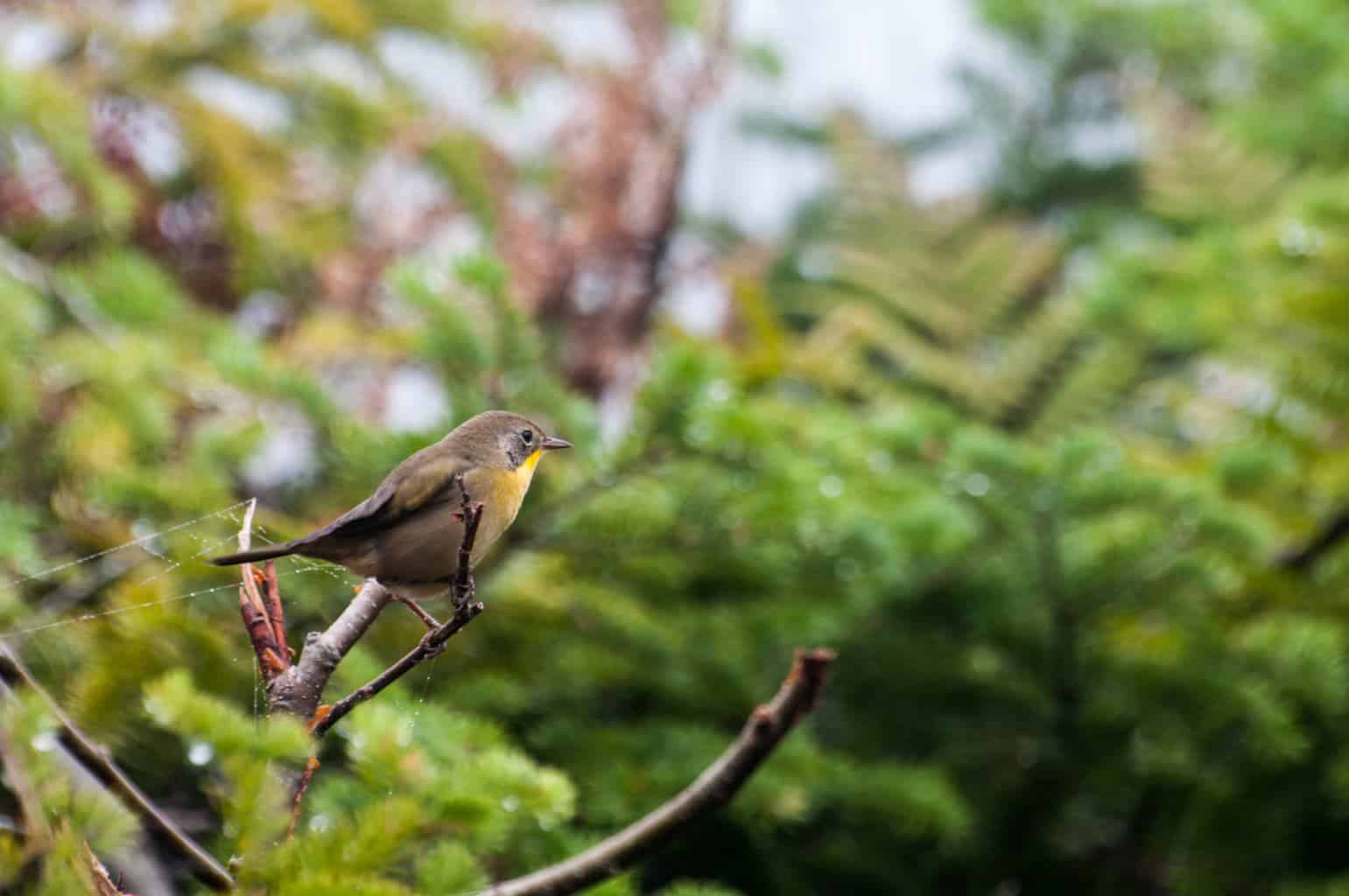
- Scientific Name: Icteria virens
- Length: 6.7 to 7.5 In
- Weight: 0.7 to 1.19 oz
- Wingspan: 9.0 to 10.6 In
This beautiful bird is commonly found in Colorado and offers a variety of lovely tones in the spring.
They have a striking yellow color that covers their breast while their back is dark olive-green. The birds have white circles around their eyes with a long tail and a large bill.
Other Birds to Watch for In Colorado
Mourning Dove
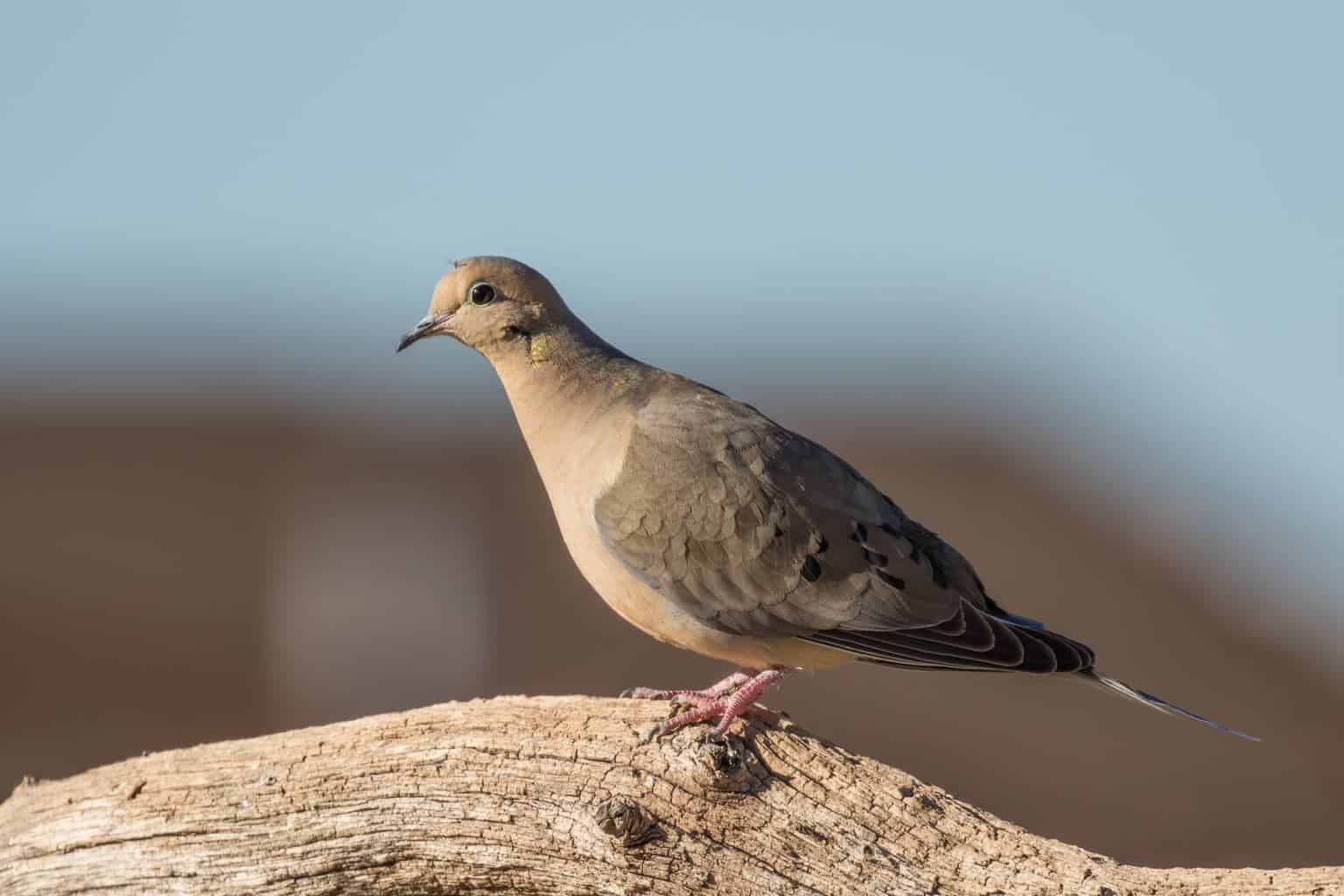
- Scientific Name: Zenaida macroura
- Length: 11.8 to 12.2 In
- Weight: 4.3 to 6.4 oz
- Wingspan: 17.3 to 18.2 In
Mourning Doves are one of the most common birds in Colorado. They are adaptable birds and can thrive in any setting. They’re seen in city parks as well as coniferous forests. Their bodies are colored in various tan and brown shades, with darker spots on the wings.
You can easily attract this common backyard bird species to your feeder by providing them with food such as seeds and millet.
Purple Martin
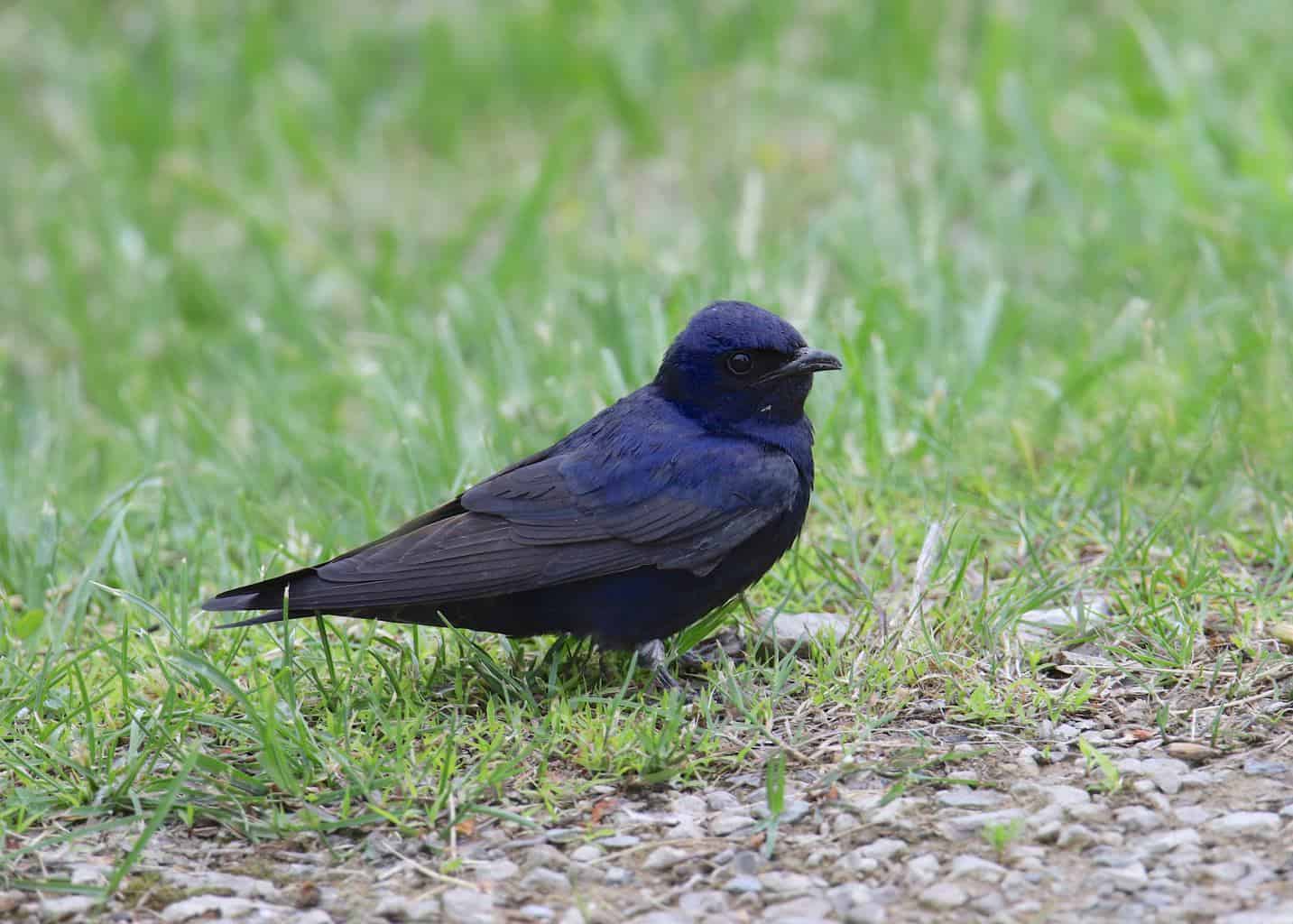
- Scientific Name: Progne subis
- Length: 7.5 to 7.9 in
- Weight: 1.6 to 2.1 oz
- Wingspan: 15.3 to 16.1 In
Purple Martins are among the most beautiful birds for birding enthusiasts. Your next bird-watching outing will be the talk of your friends if you spot one of these beloved birds. However, this one might be quite a challenge to spot, even for the most experienced ones.
This is because Purple Martins have quite a limited range in the state due to habitat loss and their slow ability to adapt to new areas.
They’re the largest of all swallows in North America and characterized by their purple-blue shaded feathers across their breast and head with grey tails and wings.
European Starling

- Scientific name: Sturnus vulgaris
- Length: 7.9 to 9.1 in
- Weight: 2.1 to 3.4 oz
- Wingspan: 12.2 to 15.8 in
The European Starling is pretty common in Colorado and you shouldn’t have a hard time spotting them. They’re about the same size as the average American Robin. They are a prime example of an invasive species as they did not originate in North America, yet they are now common.
Their plumage is mostly shiny black except for a few parts on the breast where breeding males have a green-purple iridescent tint.
However, they are only visible in summer because their plumage darkens in the winter and develops white spots instead.
White-Breasted Nuthatch

- Scientific name: Sitta carolinensis
- Length: 5.1 to 5.5 in
- Weight: 0.6 to 1.1 oz
- Wingspan: 7.9 to 10.6 in
The White-breasted Nuthatch is a must-see bird in Colorado. They’re small, compact birds and mostly white except for some grey and black markings on the back.
You’ll be able to identify them thanks to their fondness for nuts and seeds, which causes them to sneak around bird feeders. In nature, they’re found in and around deciduous forests.
Brown-capped Rosy-Finch
- Scientific name: Leucosticte australis
- Length: 5.5 to 6.3 in
- Weight: 0.8 to 1.2 oz
- Wingspan: 13.0 to 1in
The Brown-capped Rosy-Finch is another bird that is endemic to Colorado and surrounding regions.
As the name suggests, the adult finch is mainly brown to buff-colored on the back, breast, and head while having hues of pink and scarlet red on wings, rump, and belly.
Lark Bunting
- Scientific name: Calamospiza melanocorys
- Length: 5.5 to 7.1 in
- Weight: 1.3 to 1.5 oz
- Wingspan: 9.8 to 11.0 in
The Lark Bunting is another bird to look for while you’re in Colorado. However, to spot one, you should make sure that you’re there in the summer months.
The best places to find them are in the eastern and central regions of the state.
They have a distinctive dark plumage that is complemented with a few bright white patches on the wings.
Great Horned Owl

- Scientific Name: Bubo virginianus
- Length: 18.1 to 24.8 In
- Weight: 32.1 to 88.2 oz
- Wingspan: 39.8 to 57.1 In
If you’re into birding at night, owls are among the coolest birds to look for. The Great Horned Owl is one of the easiest birds to recognize due to its unique looks and iconic hooting calls. They don’t build their own nests. Instead, they use abandoned bird nests when needed.
They have an exceptional orange-colored face with multiple facial rings that radiate markings of black and white. They have tall ear tufts and are easily found in forests where they hunt down large squirrels and raccoons.
Wrap Up
You now have a better idea about the wide variety of birds found in the state of Colorado. From Yellowstone National Park to your local urban park, birds are everywhere in this state. They live in habitats ranging from farm fields to dense pine forests. You’ll even be surprised at what you’ll find perched on your backyard fences. Of course, this list doesn’t include every single bird that you may come across in the state. However, we’ve made sure to cover the most interesting, unique, or distinctive birds in Colorado and you’re guaranteed to check several off of your bird lists. So come to Colorado and listen to the beautiful bird songs and spy on, but don’t touch fragile bird eggs. It will be a trip to remember.


